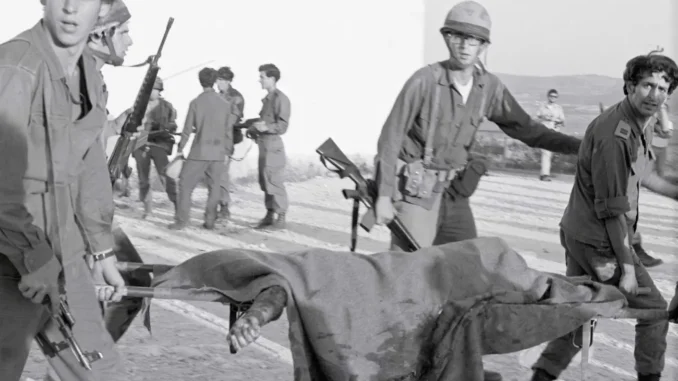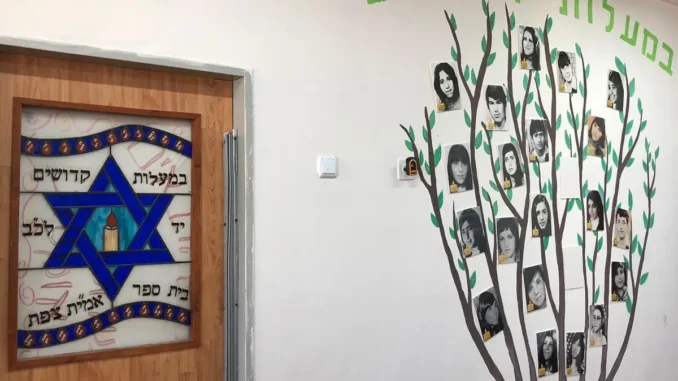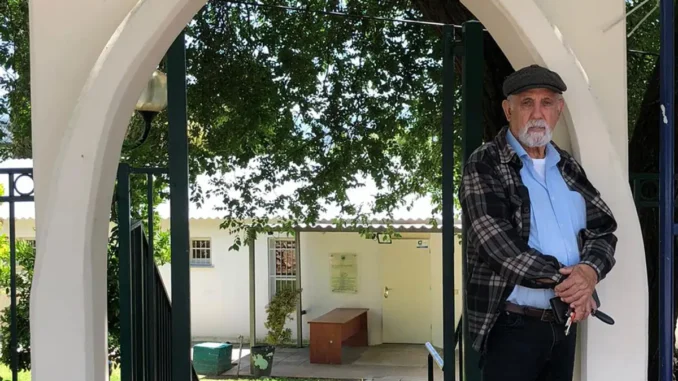Fifty years ago today, Palestinian terrorists attacked a school in northern Israel, taking hostages and murdering 22 students. The memories endure for those who survived, and the lessons learned in 1974 resonate anew for a country facing another hostage crisis.
By Hillel Kuttler, TABLET MAGAZINE 14 May 2024
 Israeli soldiers remove the body of one of the murdered students from the Netiv Meir School, May 15, 1974/DAVID RUBINGER/CORBIS/CORBIS VIA GETTY IMAGE
Israeli soldiers remove the body of one of the murdered students from the Netiv Meir School, May 15, 1974/DAVID RUBINGER/CORBIS/CORBIS VIA GETTY IMAGE
An intersection opposite the central bus station in Tzfat illustrates the interwoven trauma between that city and the Galileean town of Maalot, a half-hour’s drive away. At the intersection, one sign designates the road’s name as 22 Children of Tzfat Street, while a sign at the adjacent bus stop calls it 22 Children of Maalot Street.
Fifty years after a notorious terrorist attack that killed 28 Israelis near and in Maalot, including 22 students on a field trip from a Tzfat high school, places and people testify to the lingering pain.
It’s there a few hundred yards from the Tzfat intersection, on the Fig Kindergarten sign for the school named after Sarah Madar, “murdered in the Maalot disaster of May 15, 1974, may her memory be blessed.” Bracha (meaning blessing), a teacher there, told me that it’s one of 22 flora- and fauna-named kindergartens in Tzfat that memorialize the victims.
It’s there in Maalot’s Founders Museum, where a wall placard tells of the tragedy that began May 13, 1974, when three Palestinians who’d trained in Lebanon infiltrated Israel through the border fence a few miles north, setting off a series of security failures and attacks that culminated in the same terrorists taking more than 100 Israelis hostage in the Netiv Meir School and murdering the 22 students.
 A memorial to the victims inside the The Religious Comprehensive High School in Memory of the 22, originally named the Amit School/COURTESY THE AUTHOR
A memorial to the victims inside the The Religious Comprehensive High School in Memory of the 22, originally named the Amit School/COURTESY THE AUTHOR
It’s there down the street from the museum, where a sculpture memorializes the Cohen family, who lived in the next apartment building until the terrorists shot them to death en route to the school.
It’s in a memorial in the Maalot school building where the teens’ lives were extinguished; in Tzfat’s Amit School that they attended, since relocated and renamed The Religious Comprehensive High School in Memory of the 22; in that school’s first-floor room with a wall filled by the victims’ pictures on branches of a painted tree and, next to the tree, a stained-glass window with 22 chiseled brown circles containing their names; in a bomb shelter that a Maalot survivor renovated, inside whose entrance he hung pictures of his 22 classmates; and in the cemetery where the children were buried together down a hill from the ancient part of the city renowned for its holiness.
It is even 7,500 miles away in the Los Angeles suburb of Irvine, California, in a Reform synagogue that in 1975 renamed itself Congregation Shir Ha-Ma’alot in solidarity. The synagogue includes its namesake, out-of-the-way town on each congregational visit to Israel and a decade ago paid for the memorial site in the Maalot classroom that it also refurbished.
“It’s part of our hearts, part of our soulful connection, how much more so in the period we’re now living in,” said Richard Steinberg, the synagogue’s rabbi.
The trauma mostly resides within the people who were there that day. The recovery lives there, too, as do the lessons taken from the tragedy.
At the end of a second-floor corridor in the Maalot school, a door opened last Wednesday to reveal a classroom of third-graders at their desks facing the teacher, Shimrit Cohen.
Cohen’s mother, Dina Yakuti, survived the attack—in that very room.
Late that afternoon, I met in Tzfat with one of Yakuti’s classmates, Eli Amar, 64. He flattened his hand on his dining room table and pointed to a black speck beneath the skin near his middle finger—shrapnel from a grenade explosion in the classroom, metal that continues to set off magnetometers he passes through. Amar still experiences pain in his back, legs, and spine from a terrorist slamming him with the butt of a rifle.
To say nothing of the emotional fallout. Last spring, his 3-year-old granddaughter Adaya asked Amar why he had just spoken angrily to her. Stunned, and unsure why he had done so, he left the room. He returned and apologized.
Amar realized why he had snapped: He’d been feeling stress ahead of the Maalot anniversary’s approach, as he does every year, and being with Adaya transported him back to one traumatic moment of many. He had asked a terrorist why the gang had taken them hostage. Enraged, the man pressed his weapon against Amar’s head.
“He said, ‘If I shoot you, you won’t have children or grandchildren,’” Amar said. “I was in shock.”
He continued: “That’s why every grandchild”—Amar has seven—“is a world unto themselves. I spoil them. I take them to visit farms. I take them horseback riding.” He tilted his phone to display a clip of his 3-year-old grandson, Rom, enjoying a video Amar had texted showing motorcycles racing.
Amar cares for other people’s grandchildren, too. He worked for 32 years as a counselor to at-risk youth and taught them carpentry.
“The best way to recover is to get back on your feet and continue life,” Amar said.
The life Yakuti continued is, in part, thanks to Amar. Seconds after Israel Defense Forces commandoes burst into the classroom in an attempted rescue mission, Amar jumped onto a window ledge, pulled up a classmate, then a second and a third, all but pushing them out one at a time to safety a 20-foot drop below. He then jumped, too. Yakuti was shot when she landed, but she recovered. Another student who jumped was murdered.
“I was afraid because of the height. He didn’t give me a moment to think,” Yakuti, 67, said of Amar. “He was the messenger of good.”
For 20 years, Yakuti wouldn’t discuss the episode except in therapy. But questions from her five children and 21 grandchildren gradually melted her reticence. Two years ago, Cohen addressed fifth- and sixth-graders in the school’s memorial room. She brought her parents along and prompted Yakuti to discuss the episode. It was the first time her mother publicly did so.
Before that day, Yakuti hadn’t returned to the building. Because the memorial room was carved out of a portion of the corridor and part of the original classroom, Yakuti was confused, thinking she was in the wrong place.
She would go on to address additional groups there.
“When I enter the room, it’s full of all the associations of what happened, and it’s difficult. What’s hardest is [remembering] friends who were murdered,” Yakuti said. “We speak of 50 years ago, but when I enter the room it’s like yesterday. I see the pictures there and I see everything from the past, every detail, very clearly. When I see the kids’ photos, I think of all our experiences together.”
May 14, 1974, began with two buses, a large van, and a car setting out from Tzfat on a three-day outing to hike and sleep under the stars. They approached Moshav Avdon for the group to begin its first hike down to a wadi, and encountered a military vehicle. The soldiers prevented the convoy from proceeding, saying that they’d received reports of terrorists infiltrating from Lebanon.
One of the teachers—Amar remembered the group including five or six teachers, two nurses, and two armed guards—called the principal, who altered the plans. They’d hike elsewhere and sleep in buildings, not outdoors. That night, they went to Netiv Meir and rested in their sleeping bags on the floor: adults on the ground level, boys on the first floor, and girls on the second floor. A large group sat in the courtyard late into the night talking and snacking. At 3 or 4 a.m. on May 15, Amar and his friends went to sleep.
No one knew that terrorists were en route, determined to attack a school. Unfamiliar with the area and costumed in IDF uniforms, they asked a series of residents where the nearest school was. A street sweeper directed them to Netiv Meir and got a bullet for his trouble.
The terrorists planned on waiting for pupils to arrive the next morning at what was then, and remains, an elementary school. After entering the complex at about 5 a.m., they heard children talking. They’d hit the jackpot.
Negotiations with Israel’s government followed the terrorists’ capture of the students and adults. Then came the commando raid that killed all three terrorists and ended the episode—but not before the terrorists had killed the 22 students.
But some of the actions and failures remain branded into Israelis’ consciousness 50 years later, with Maalot’s echoes reaching the ongoing crisis of the 132 hostages held by Hamas in Gaza since Oct. 7.
Several parents of the Gaza hostages occasionally scream threats against the government if it doesn’t bring their loved ones home alive. Nothing like that occurred around the Maalot crisis, said Bezalel Dahan, who as a teacher in Tzfat at the time knew many of the families of the kidnapped students.
 Bezalel Dahan stands at the entrance to Maalot’s Founders Museum, which he runs/COURTESY THE AUTHOR
Bezalel Dahan stands at the entrance to Maalot’s Founders Museum, which he runs/COURTESY THE AUTHOR
The Maalot victims’ parents continued to love Israel “unconditionally, even if their child was murdered,” Dahan said. That might be because the students all came from North African families, immigrants from Tunisia, Morocco, and Libya, Jewish cultures for which the Zionist connection was deeply religious, he said.
“If the parents of the kidnapping victims today say they’ll burn down the state or leave the state, then we’ve learned nothing,” Dahan said.
Maalot marked an enduring turning point in several ways.
Israeli governments historically had refused to negotiate with terrorists, believing that doing so encouraged further hostage-taking. That taboo fell in Maalot. The IDF was ill-suited to undertake hostage-rescue raids, and it bungled the Maalot rescue in a variety of ways. The Maalot failure spurred the formation of Yamam, a well-trained hostage rescue-commando unit under the aegis of the police department.
There’s also the question of adults’ responsibility for minors. Israelis prize children, and the pressure exerted by the kidnapped children’s parents forced then-Prime Minister Golda Meir to negotiate with the terrorists, who demanded the release of Palestinian prisoners. Yet nearly all of the Amit teachers escaped via a back door after the terrorists infiltrated, leaving the kids to fend for themselves.
“You can’t abandon kids. A teacher must sacrifice his life,” Dahan said.
All in all, Maalot was “a big debacle,” said Efraim Inbar, president of the Jerusalem Institute for Strategy and Security. “Rescue operations should end with as few casualties as possible.”
In a hostage situation, he said, “it’s always better to end it with decisive action, not give in to terrorists’ demands.”
Yakuti and her family live in Dovev, a moshav alongside the border with Lebanon, but were relocated to Tiberias when Hezbollah opened a second war front against Israel following Hamas’ Oct. 7 massacre. For her, the trauma of Maalot lingers 50 years later in sounds. On hearing a blast, she jumps—the Maalot firefight. Announcements made via loudspeakers—the megaphone through which one of the terrorists barked demands to Israeli negotiators. Merely hearing the word terrorist shakes her up. Cohen remembered her mother insisting on the strongest front doors with impenetrable locks for their home.
I asked about Maalot’s legacy. Yakuti bounced back and forth on Israel’s timeline: Oct. 7, Palestinians’ pogrom against Jews in Hebron in 1929, the Holocaust, each of Israel’s wars, Maalot, Palestinians’ massacre of Jews in nearby Kiryat Shemona earlier in April 1974, the 1976 airplane hijacking and rescue in Entebbe, Uganda.
Yakuti then said she confronts this question in two ways. First, “everything in the state has associations, unfortunately.” There’s also gratitude. “We could have all been killed. I could have been killed in one fell swoop,” she said. “The Jewish people will continue with God’s help. … Our destiny is to suffer, but thank God we’re strong.”
Yakuti’s spirituality deepened years after Maalot. Reading Psalms helped, she said.
The California congregation’s name, Shir Ha-Ma’alot, means Song of Ascent. Fifteen psalms begin with those words. To this day, Jews worldwide recite one or more of the Shir Ha-Ma’alot psalms when praying for someone’s return to good health or for a community in peril.
I asked Rabbi Steinberg which Shir Ha-Ma’alot psalm connects him best to Maalot.
“Psalm 126: ‘Those who sow in tears will reap in joy,’” he answered. “That classroom has been filled in tears, including my own, and now it has the sound of children.”
Hillel Kuttler, a writer and editor, can be reached at hk@HillelTheScribeCommunications.com.



Leave a Reply
You must be logged in to post a comment.